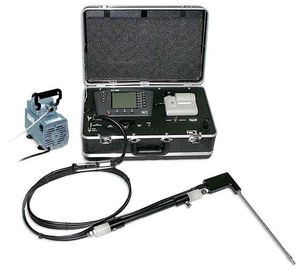Difference between revisions of "Dust Emission Analyzers"
| (One intermediate revision by the same user not shown) | |||
| Line 1: | Line 1: | ||
[[Category:Analyzing]]{{Knoppen}} | [[Category:Analyzing]]{{Knoppen}} | ||
[[File:Dust Emission Analyzers.jpg|thumb|right|Dust Emission Analyzers]] | |||
'''Dust Emission Analyzer''' is a stationary or portable instrument for measuring suspended particulates in a liquid or gascolloid. It measures suspended particulates by employing a light beam (source beam) and a light detectorset to one side (often 90°) of the source beam. Particle density is then a function of the light reflected into the detector from the particles. To some extent, how much light reflects for a given density of particles is dependent upon properties of the particles such as their shape, color, and reflectivity. | |||
Dust emission analyzers are calibrated to a known particulate, then use environmental factors k-factors to compensate lighter or darker colored dusts accordingly. K-factor is determined by the user by running the dust emission analyzer next to an air sampling pump and comparing results. | |||
Latest revision as of 10:04, 31 January 2013
Dust Emission Analyzer is a stationary or portable instrument for measuring suspended particulates in a liquid or gascolloid. It measures suspended particulates by employing a light beam (source beam) and a light detectorset to one side (often 90°) of the source beam. Particle density is then a function of the light reflected into the detector from the particles. To some extent, how much light reflects for a given density of particles is dependent upon properties of the particles such as their shape, color, and reflectivity.
Dust emission analyzers are calibrated to a known particulate, then use environmental factors k-factors to compensate lighter or darker colored dusts accordingly. K-factor is determined by the user by running the dust emission analyzer next to an air sampling pump and comparing results.
